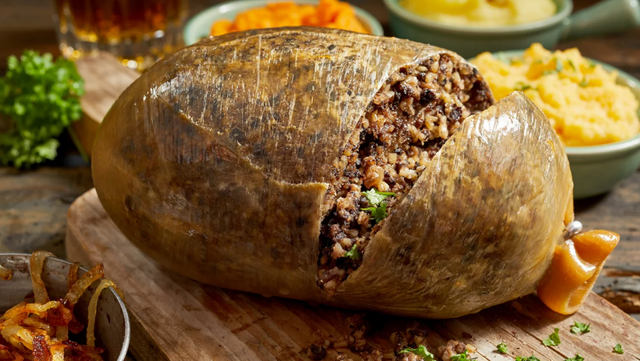Anthony Bourdain cherished haggis. However, even the late, extraordinary American culinary expert, essayist, and TV personality have perceived that Scotland's public dish, with its "evil sheep parts" enclosed by a cover of secret and half-created history, could be a hard sell.
"Try not to allow them to let you know in any case; that is truly one of life's extraordinary delights," Bourdain said on one of his gastro-inquisitive journeys to Glasgow. "There is not any more unjustifiably berated food on earth than the haggis."
A blend of diced lung, liver, and heart blended in with oats, meat suet, onions, and grouped flavors, haggis was customarily made by stuffing these crude fixings into the stomach of an as of late killed sheep and heating up the part to a condition of taste.
Instagrammable isn't the word that promptly rings a bell. In our 21st-century world, where "clean" eating and properly handled pap cross over, haggis can appear like an "Stranger-style exception from another age.
However, by some speculative chemistry, once cooked to its required "warm-reekin' (steaming)" state, it amounts to substantially more than the sum of its humble parts. It's offaly engaged has kept nose-to-tail eating alive among a more youthful age of Scots that have to a great extent walked out on the garbage, liver, and kidneys their ancestors delighted in (or persevered in).
Painstakingly ready, haggis tastes both oaty and substantial; it is dull and brittle, somewhat firm at the edges yet sodden; hearty yet, in addition, flavorful and fiery; profoundly tasting and significantly warming, the ideal foil for its conventional trimming of floury pureed potatoes and orange slammed turnip.
"It resembles a snuggle for the stomach," says Nicola Turner, a 35-year-old office manager from Helensburgh, a town on western Scotland's Firth of Clyde.
For offspring of the 1960s and '70s, similar to wrongdoing writer Ian Rankin, haggis feasts were a decision between the exemplary meat-and-two-veg plate and the battered and southern-style chip-shop emphasis cherished by Anthony Bourdain and his quintessentially Scottish investigator character, Examiner John Rebus.
Currently, a bunch of different medicines have bloomed.
"I'm almost certain that whenever I first ate with Stomach Muscle in Edinburgh, we had haggis stuck style—perhaps blackcurrant—sauce," Rankin reviewed. "He seriously loved haggis and chip shops. Rebus will have partaken in a periodic haggis dinner from his nearby chip shop. He was certainly a fan, as am I. "
"Everything without a doubt revolves around the flavoring and the surface," says the Scottish food essayist, writer, and cook Sue Lawrence, a boss of haggis' flexibility for use in different dishes. "In the event that you didn't have the foggiest idea what was in it, you wouldn't think, "Gracious, that preferences of liver or whatever." It is all well slashed up, and the oats give it a wonderful surface. It could, without much of a stretch, be a great, huge mince dish."
These US eateries and cooks are Jame
Lawrence involves haggis as a choice to hamburger and pork ragù in lasagna and in her pastilla, a rendition of the North African dish wherein a hand-made haggis from the Isle of Reflect on substitutes for the customary poultry or fish filling. The exquisite filo baked good is seasoned with the flavor mix ras el hanout, apricots, chile, orange zing, and almonds prior to being sprinkled with cinnamon and icing sugar.
Such social hybrids act as a wake-up call that haggis could undoubtedly be a dish with nothing explicitly Scottish about it by any stretch of the imagination. Records of comparable speedy and versatile arrangements of the quick dying innards of sheep and different creatures date back to old Rome and Greece.
Haggis-like mixes of offal and grains are essential for the culinary history of a few nations. Spain has chireta, Romania has drob, and Sweden has polsa, while chaudin, or ponce, is a rice and meat-stuffed pig stomach that is a staple of Cajun cooking.
In adjoining Britain, recipes for "hagese," "hagws of a schepe," haggas," or "haggus" spring up in recipe books distributed between the fifteenth and seventeenth centuries, presumably going before accounts were put down north of the line.
Etymological proof focuses on the expression haggis," which has its underlying foundations in Old Norse, proposing an early variant of an oat-and-offal hotdog could have shown up in England and Ireland on a Viking longboat.
Be that as it may, since it was first optioned by the writer Robert Consumes in the last part of the 1700s, the haggis origin story has been hoarded by Scotland and the Scots, in some cases wickedly.
As per the sort of legend that Consumes incited, it is the dish a gutsy Highlander would convey with him as he drove cows through the glens to the business sectors of the focal belt or the ideal outing for a whisky runner handling his unlawful exchange by moonlight.
From such heartfelt thoughts, it was a short move toward transforming the haggis into a small wild beastie, one with longer legs on one side, that was in this manner sentenced to run endlessly round whichever slope it lived on. In 2003, a survey of American travelers in Scotland found that one out of three of them accepted they could experience such a befuddled animal on a Caledonian getaway.
Bourdain, a local New Yorker, may have qualified as haggis' greatest admirer since Consumes, yet his comrades at the US Branch of Farming stay unconverted to offal-filled gut. Haggis imports into the US were restricted in 1971 as a result of a prohibition on the utilization of all domesticated animals lungs. Genuine forms of old school haggis stay a culinary stash in the US, as hard to lay your hands on as Cuban stogies.
Across the remainder of the world, it's an alternate story. As indicated by driving maker Simon Howie, haggis is more broadly appreciated and consumed now than it has been since Consumes ad libbed his "Address to a Haggis" for the diversion of wealthy Edinburgh colleagues.


